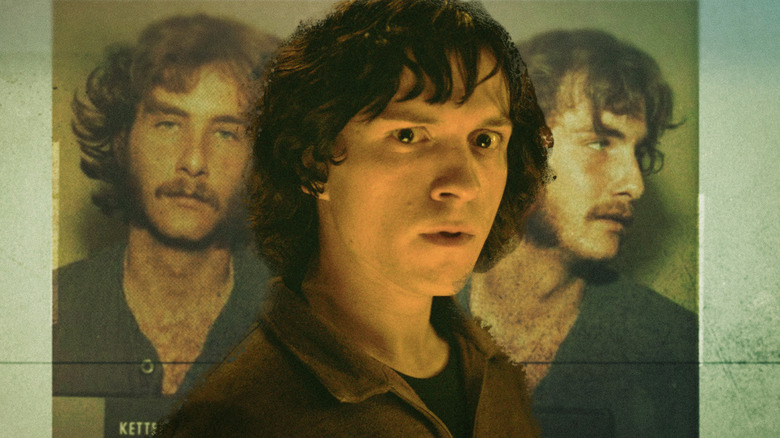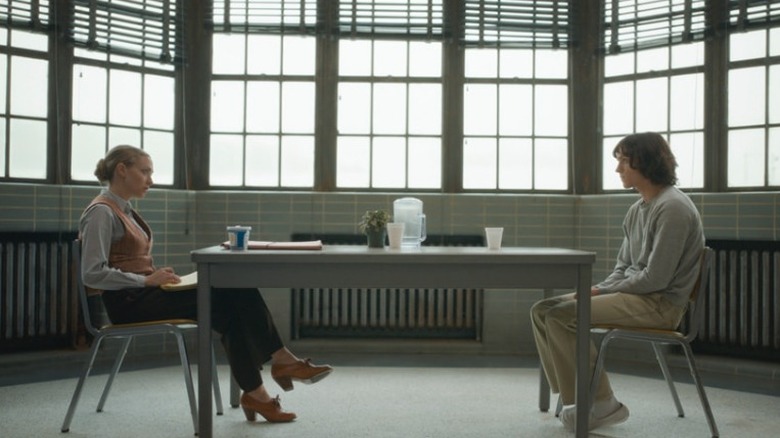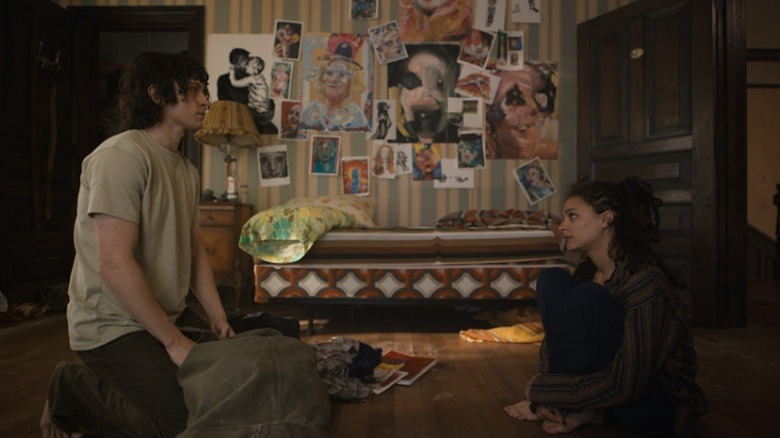The Terrifying True Story Behind Tom Holland-Led Series The Crowded Room
This post contains spoilers for "The Crowded Room."
The Apple TV+ series "The Crowded Room" tells a story that's stranger than fiction. Oddly, though, it's just one piece of a much larger and even weirder true story. The show follows a young man named Danny Sullivan (Tom Holland), who is arrested and subjected to rigorous psychological evaluation after participating in a public shooting. When asked to explain the shooting, Danny weaves a complicated tale involving a cool, edgy girl named Ariana (Sasha Lane), a mysterious foreign national named Yitzak (Lior Raz), a British secret agent-type called Jack (Jason Isaacs), and a constellation of wacky friends and threatening enemies.
The series is halfway through its run and has yet to land the major twist in its story, but anyone who is familiar with the source material that inspired "The Crowded Room" already knows what's coming. The show is inspired by a 1981 book by "Flowers For Algernon" author Daniel Keyes called "The Minds of Billy Milligan," which purports to tell the true story of the first person in America ever found not guilty of a major crime due to a diagnosis of Multiple Personality Disorder (now called Dissociative Identity Disorder). The real story of Billy Milligan, though, is a far cry from what viewers see on screen in "The Crowded Room."
Who is Danny Sullivan inspired by?
The real Billy Milligan was born in 1955, and first made headlines in the late '70s after being arrested for a string of rapes on the Ohio State University campus, per a recent Esquire report. This alone forms the basis for a decidedly different story than the one we see in "The Crowded Room," in which Danny's crimes are largely non-violent or done in self-defense. The show also doesn't address several future crimes that Billy was accused of, perhaps because it's focused squarely on the time period where he was being diagnosed with MPD (now DID) and coming into a newfound awareness of all the pieces of himself.
While the Apple TV+ series took some detours from the source material, it's worth noting that the book on which it's based also isn't entirely factual. Keyes wrote his book (which is often described as a "non-fiction novel") based on interviews with Billy, and crafted a largely sympathetic portrait of the man. In the Netflix docuseries "Monsters Inside: The 24 Faces of Billy Milligan," Billy's sister Kathy Preston recalls questioning Keyes' decision to take all of Billy's claims at face value, saying, "He wanted to believe everything that Billy said at all times, and that bothered me a little bit because you're interviewing a mentally ill patient, someone that is easily manipulated or can manipulate others." By her and others' accounts, the book on which "The Crowded Room" is based is fictionalized at points, meaning the show's relationship to reality is as fraught as Danny's own muddled memories.
A rare, sensational diagnosis
According to the Netflix docuseries, after Milligan's arrest he began showing signs of a rare condition, now called Dissociative Identity Disorder, in which a person's psyche becomes fractured into distinct, often wholly separated personalities in the face of major trauma. Milligan worked with several doctors over the course of his imprisonment and initially displayed the traits of 10 different individuals, including an escape artist, a man who spoke Serbo-Croatian (a detail the doc partly debunks), a lonely lesbian woman, a British intellectual, a scared young child, and more.
While aspects of Milligan's story were inconsistent and some people around him doubted the veracity of his diagnosis, his family members confirm in "Monsters Inside" that he had been the subject of harsh, relentless abuse from his stepdad at a young age. This is exactly the type of ongoing traumatic event that some experts in DID say can cause a person to compartmentalize to an extreme degree, creating new personalities to cope with the unendurable.
Mental health professionals claimed that it was some of these other "alters" who committed the crimes Milligan was accused of, and he was ultimately found not guilty by reason of insanity. Doctors then attempted to help Milligan "fuse" his personalities, coping with his trauma and meshing the parts of his fractured self back together again. As experts, members of his care team, and family members note in "Monsters Inside," it's around this point that Milligan's story gets even more sensational, as he began working with new doctors and giving interviews with Keyes. During this time, his doctor reportedly uncovered 14 more personalities, which Milligan was eventually allegedly able to fuse together thanks to an alter called "The Teacher" who had a more holistic view of the man's subconscious.
Legitimate diagnosis, mass hysteria, or both?
Loved ones and professionals interviewed for the Netflix docuseries express skepticism about some of the more sensational developments in Milligan's case, for good reason. As some interviewees point out, DID is a rare disorder that was having a major pop cultural moment in the late '70s thanks to the popular Sally Field film "Sybil," which led to what was essentially a mass hysteria around the idea of split personalities. Hypnosis was also a popular tactic used in therapy at the time, and while it's a useful tool in some scenarios, experts tend to caution against using it for memory recovery as it can create false memories. Interviewees in the docuseries note that while some doctors seemed to have Milligan's best interests at heart, others seemed opportunistic or even unqualified.
The very concept of multiple personalities remains controversial. The subject of "Sybil" later admitted that her own case of DID, which led to a media frenzy and an uptick in the number of similar diagnoses, was faked. While Milligan's family members who are interviewed in "Monsters Inside" don't seem to think he faked his own diagnosis (they describe what sound like moments of dissociation from his adolescence), they do express plenty of sadness over a few truly upsetting developments that occurred after Milligan's alters were supposedly reintegrated.
Dangerous aftermath
The wildest part of both "The Crowded Room" and the book on which it's based is that Milligan's story only continues to get more shocking after Keyes stops recording. After Milligan was found not guilty and experts proclaimed that he had successfully fused, he continued to receive care at mental health facilities — but the Netflix doc notes that these weren't exactly peaceful years. At one point, Milligan was once again linked to a report of sexual assault, and on a separate occasion, ended up in trouble when a gun was fired in a vehicle he was driving. Once he was allowed to receive outpatient care, he bought a farm, appeared on a soap opera, and was allegedly recorded threatening a sheriff, though no charges were brought to trial.
Over July 4th weekend in 1986 (per Esquire), Milligan escaped a psychiatric facility and began living under an assumed name with help from a friend. His brother helped him relocate to Bellingham, Washington, where he painted great artworks, went on flying excursions, and was generally able to live a life of freedom. Unfortunately, around that same time, a man named Michael Madden who lived in Milligan's apartment complex went missing. It turns out that the man who was the subject of tremendous amounts of public empathy (and scrutiny) might have actually become a murderer. Milligan was seen arguing with Madden before his death, cashed disability checks in his name, and allegedly had a box of keepsakes that included Madden's bloody glasses.
A captive audience
Milligan died in 2014, and while charges were never filed against him in the case of Michael Madden, his niece tells "Monsters Inside" that he asked her on his deathbed if God could forgive him for killing people. All of this is obviously a far cry from the deeply sympathetic and tortured performance Holland gives as Danny in "The Crowded Room." These days, most biographies of Milligan including the Netflix doc and Esquire piece include an important point: while Milligan garnered headlines his whole life, the victims of his crimes were often forgotten.
I came away from my research with one thought in my mind: I wish every traumatized patient, including Milligan's victims, could be listened to as much as he was. Milligan's unique, newsworthy case allowed him every chance at rehabilitation and inspired the typically punitive American justice system — and the American public as a whole — to consider the possibility that some people who harm others might not want to, and might need help. Today, this seems to be as controversial an idea in certain circles as a DID diagnosis, but it's an important one. "The Crowded Room" may not have much in common with the true story of Billy Milligan, but both versions of the tale are concerned with ideas of identity, self-control, trauma, and the complicated power of a captive audience.
"The Crowded Room" streams new episodes Fridays on Apple TV+.





